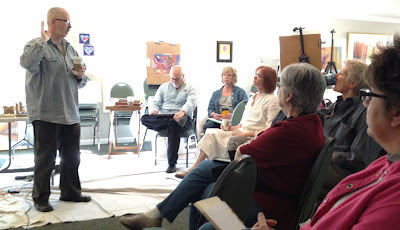Wednesday, May 30, 2012
The Colorist: Pastel Studio, Canada
Thursday, May 24, 2012
Denver Workshop Photo Report
Monday, May 14, 2012
Tuesday, May 8, 2012
Visual Pathways
Visual pathways are a function of lines, shapes, movement and space. Are you offering your viewer a clear path into your picture, or a fence to block him out? What about within the space? You'll want to organize your space to create movement and suggest pathways.
Now consider how each line of the mid ground and back ground leave the frame. They are either straight, or, if they are trying to dive down, I turn them straight at the last. Note this on the upper left and right, where the mountain would otherwise want to naturally flow downward. If the red arrows obscure this, look at the image posted above. Like a used car salesman, I am keeping you by the collar, and persuading you to stay in the picture.
This deceptively simple landscape has multiple pathways into and around the picture. It avoids triangles in the corners, which I call bilges. The lavender swath that enters the bottom of the space, which also splits the lower left corner, begs you in and draws your eye to the trees that are the focal point of the image. The trees connect directly to the far hills, and so unify the parts of the space.
One artist described visual pathways as linking values, not just lines, to organize a visual pattern. I recommend George James' video here.
One artist described visual pathways as linking values, not just lines, to organize a visual pattern. I recommend George James' video here.
One of the tricks we learn from the graphics world is to insure that our entry or exit lines on each side do not point downward. This is a greased rail out of the picture plane, and a rude invitation to the door. Make the lines enter and exit at an upward angle. How can one possibly achieve this? If you must draw a line downward, surround it with more upward lines, and the gaffe may be forgiven.
Consider the red lines I have added in the pastel below. Three offer access to the picture from the bottom left, which is the "school solution" for the attention of the western mind - we read from left to right. None come exactly from the corner. There is an ancillary line at the right side of the tree, which points upward - if it pointed down, that would be an unkind invitation to leave the scene.
Now consider how each line of the mid ground and back ground leave the frame. They are either straight, or, if they are trying to dive down, I turn them straight at the last. Note this on the upper left and right, where the mountain would otherwise want to naturally flow downward. If the red arrows obscure this, look at the image posted above. Like a used car salesman, I am keeping you by the collar, and persuading you to stay in the picture.
The corners at the bottom of a painting seem like attractive places to drop triangles for the beginner. The awful result is what I call the "bilge" area of the painting space. It is the place where we discard irresolute thoughts and actions.
Bilge in the corner - makes it a clunker.
Bilge in the corner makes it a clunker.
Monday, May 7, 2012
Tuesday, May 1, 2012
Subscribe to:
Posts (Atom)


























